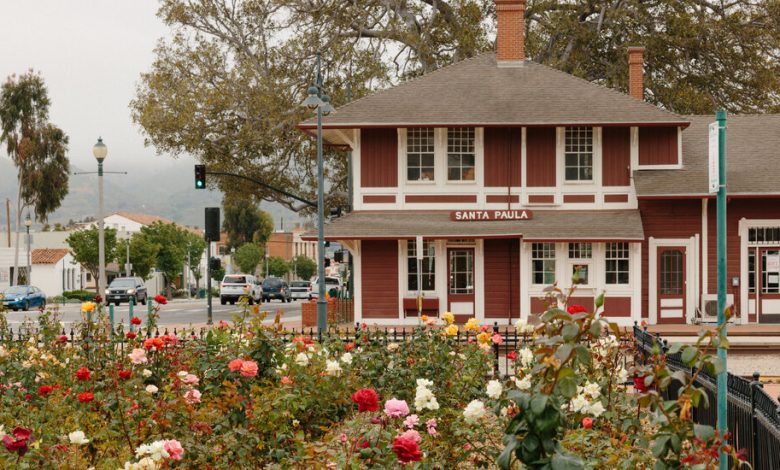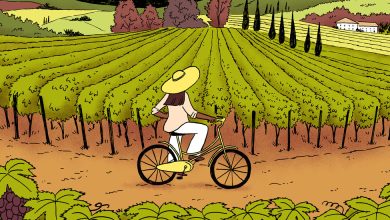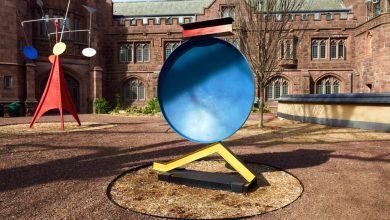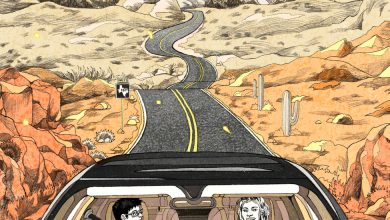Southern California Beyond the Freeway

Perhaps nothing defines Los Angeles like the freeways: ribbons of asphalt and steel (and traffic jams) tying coast, valley and mountains together in a multilane, limited-access web. These highways were considered so essential that planners nearly jammed one right through the center of swanky Beverly Hills.
But it wasn’t always this way. Before the first freeway opened in December 1940, Angelenos got from place to place on lazy two-lane roads that cut through a classic Southern California landscape of hills, canyons, ranches, and orange and avocado farms, some following the original stagecoach routes.
Fortunately, many of these back roads still exist, even if the citrus groves have transmogrified into mostly multimillion-dollar homes. One sunny morning, I set out on a route from my home near the San Fernando Valley to the wine country northwest of Santa Barbara, close to 100 miles away. My mission: to discover the unexpected museums, hundred-year-old restaurants, small towns and other sites that have endured but remained hidden from the cars whizzing by at 75 miles per hour.
1. Plummer House/Leonis Adobe
2. King Gillette Ranch
3. The Old Place
4. Satwiwa Native American Indian Cultural Center
5. Mullin Automotive Museum
6. California Oil Museum
7. Ojai Valley Overlook
8. Boccali’s Pizza and Pasta
9. Lake Casitas
10. Cold Spring Tavern
Old Hollywood and a ranch that razors built
The off-piste adventure begins by exiting the 101/Ventura Freeway in Calabasas, at the Valley Circle turnoff. The town is home not only to the Kardashians, Kevin Hart and other celebrities, but also to a blue Victorian bungalow once known as the “oldest house in Hollywood,” despite now being many miles from the Walk of Fame. Built in the 1870s, the Plummer House was relocated here in 1983 from what is now Plummer Park in West Hollywood.
The Plummer House sits next to its contemporary, the Leonis Adobe, built for Miguel Leonis, a French Basque immigrant and major Los Angeles landowner nicknamed the King of Calabasas. The two-story adobe brick home with wraparound verandas remains furnished as when it was first occupied in the 1870s. Admission to the Leonis Adobe museum is available on weekends only, at no charge.
A more modern attraction in Old Town Calabasas, a collection of modest clothing shops and eateries that has grown up in the surrounding former farmland, is Sagebrush Cantina, a nearly 50-year-old Mexican restaurant featuring live music and karaoke.

The Sunday-night crowd at a taco truck in Somis, Calif., along the route between Oxnard and Santa Paula.Credit…Stella Kalinina for The New York Times
At the intersection of Las Virgenes Road and the famed Mulholland Highway — which opened in 1928 — you’ll find the 588-acre King Gillette Ranch, the namesake of the razor magnate who once owned it. Free to visit and now part of a national recreation area, the ranch showcases a 1920s Spanish Colonial Revival mansion designed by Wallace Neff, an early-20th-century architect credited with creating the “California style.” The house and grounds, approached by driving down a long eucalyptus-tree-lined road, were settings for the TV series “The Biggest Loser.”
Emerging from the woods along the Mulholland Highway, a dark, rustic cabin signals you’ve reached the Old Place restaurant. The building, which served as the Cornell, Calif., post office until 1970, is owned and run by Morgan Runyon, the son of the founder, Tom. If the name Runyon sounds familiar, it may be because the clan once owned Runyon Canyon, now a park in the Hollywood Hills whose hiking trail draws celebrities.
Clad in wood inside and out, the restaurant, which specializes in steaks grilled over local red oak, is open Thursday through Sunday, and offers tight seating inside, as well as in the adjacent old mail sorting room and tables scattered among the trees on the large, rural property.
See a Chumash village, then gawk at old cars
As you head toward the foot of the Santa Monica Mountains and the community of Hidden Valley on Potrero Road, the suburbs give way to pastures. The area, nestled against the mountains, is known for horse breeding and famous former residents like Ellen DeGeneres and Sophia Loren, as well as current ones like Britney Spears. Its minimum-eight-acre lots line the roadside behind white picket fences, creating a backdrop that has served as the setting for many car commercials.
Descending the steep, curving road to the coast, you pass the Satwiwa Native American Indian Culture Center, part of a National Park Service site preserving a former Chumash village. On weekends, Native American guides are available to discuss the Chumash culture and show visitors a replica of a Chumash home, a domelike structure called an ’ap. There is no charge to visit.
Once you are on flatter land, get ready to jostle with slow-moving farm trucks as you pass by tiny cottages and roadside farm stands hawking two-for-$1 avocados.
If you love old cars and you are traveling on a Friday or a Saturday, take a detour to the Mullin Automotive Museum. Founded by Peter Mullin, an insurance industry executive, the museum, hidden in a nondescript industrial park in the town of Oxnard features French vehicles from the 1890s to the present. The collection includes everything from a boxy, pristine open-cabin 1910 Renault to streamlined 1930s vehicles, as well as a large collection of early Bugatti racing cars. And they’re all housed in an Art Deco-style interior.
An oil rig and a stagecoach stop
Across the Santa Clara River, you’ll find the quiet town of Santa Paula, its main street a string of low-slung connected shops. On a prominent corner along Main Street, the California Oil Museum occupies the original oversize 1890s Victorian headquarters of the Union Oil Company, serving up a history of California’s oil industry, and featuring a working 19th-century oil rig.
As Main Street becomes Route 150, you’ll cruise down a lush winding road devoid of other vehicles, passing by citrus groves and through thick wooded areas. Be sure to stop at the Ojai Valley Overlook. This rest stop offers a bird’s-eye view of the green Ojai valley floor and farmland below, in a bowl surrounded by the Topatopa Mountains.
On your descent into the Ojai valley, you’ll pass Boccali’s Pizza and Pasta, part of the Boccali family winery. The restaurant has the air of a bistro one might encounter bicycling through an Alpine village in Slovenia, along with extensive outdoor seating. The build-your-own-pizza menu also features an assortment of standard pasta dishes. A stand on the porch offers farm-grown 50-cent grapefruits and lemons, $10 bags of oranges and $1 avocados. Payment for the produce is on the honor system.
You’ll then circumnavigate almost all of Lake Casitas, a three-mile-long reservoir that provides drinking water to Ojai and surrounding areas. Fishing, boating, and camping are allowed, but don’t even think about taking a swim: As the water is for human consumption, bodily contact is forbidden.
Passing through Montecito on Route 192, you’ll see plenty of hedges and imposing gates concealing multiacre estates priced in the $10 million to $25 million range — and up. Close to but still secluded from Santa Barbara, the town is home to such luminaries as Oprah Winfrey and the Duke and Duchess of Sussex, a.k.a. Harry and Meghan. John and Jacqueline Kennedy honeymooned at the secluded San Ysidro Ranch, where accommodations now start at $2,495 per night, plus taxes, meals included.
Northwest of Santa Barbara, just over San Marcos Pass, you’ll find Stagecoach Road. Named for the vehicles that originally traveled it, the road parallels Route 154 before plunging through a wooded area to the Cold Spring Tavern. This structure, which began as a stagecoach stop in 1868, drew travelers looking for respite from the bumpy ride — as well as those looking to rob the cash boxes carried by Wells Fargo.
The menu of the rustic vine-covered restaurant with a wood-and-stone interior is heavily weighted toward meat, offering modestly priced burgers as well as chicken, steak, tri-tip, and wild boar. It sits next to a tiny, abandoned jail — brought over the mountains from Ojai — and a road gang house built in 1868 by 11 Chinese immigrants to sleep in while they worked on the road over San Marcos Pass.
Land of 5,000 olives
From the Cold Spring Tavern, you’ll continue driving along a two-lane mountain road, past grazing cattle and burned-out tree stumps that mingle with fresh growth, lingering evidence of the sometimes catastrophic wildfires that occur every few years.
In 30 minutes, you’ll reach Los Olivos, a rural community with a small-town feel. Founded in 1887 as a stagecoach stop and still graced by some Victorian homes, the town was originally named after 5,000 olive trees in a local ranch.
Grand Avenue, its main street, is home to tasting outlets of local wineries, a handful of clothing stores and galleries with crafts, art and photographs.
Panino offers a wide range of grilled sandwiches and salads. The Los Olivos Wine Merchant and Café sells more than 250 wines in its shop, while its restaurant features mostly local produce, as well as fish and meat dishes.
For those looking to stay the night, the 15-room, Victorian-style Ballard Inn tempts travelers with a wraparound porch, a happy hour with wine and snacks, and a secluded setting in the nearby village of Ballard. Depending on the time of year, rates can start at around $245 a night.
In Los Olivos, the newly reconstructed Inn at Mattei’s Tavern, now part of the Auberge chain, offers upscale accommodations, with rooms from about $630, depending on the time of year.
Wherever you stay or how long you spend enjoying Los Olivos, one thing is almost certain: If you take the freeway back to Los Angeles, you’ll be there in half the time — with more than twice the traffic. But if you choose the back roads, with their curves, historic sites, overlooks, restaurants and roadside attractions, those extra hours on the road will be time well spent.
Follow New York Times Travel on Instagram and sign up for our weekly Travel Dispatch newsletter to get expert tips on traveling smarter and inspiration for your next vacation. Dreaming up a future getaway or just armchair traveling? Check out our 52 Places to Go in 2023.



